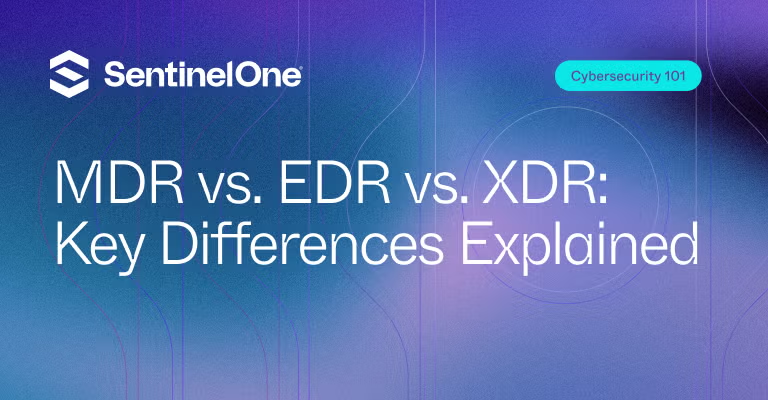According to Verizon’s 2024 Data Breach Investigations Report, over 68% of breaches involved some sort of human element. Robust cybersecurity solutions have never been more important, given the fact that ransomware and extortion attacks accounted for nearly one-third of all breaches. Yet with tools such as EDR, MDR, and XDR now commonly available, a question lingers: how do you know which suits the security needs of your organization best?
This article will help you differentiate between endpoint detection and response (EDR), managed detection and response (MDR), and extended detection and response (XDR), MDR vs EDR vs XDR. Knowing the strengths of each and their various challenges will serve you well in protecting your systems and making the right choice for your organization. Whether a developer or a security engineer, it is of great importance to understand how those solutions keep cyber threats at bay.
So, what exactly is MDR, and how does it compare to EDR and XDR? Let’s start there.
 What Is Managed Detection and Response (MDR)?
What Is Managed Detection and Response (MDR)?
MDR integrates advanced technology with skilled professionals to deliver real-time monitoring, threat detection, analysis, and rapid response to cyber threats. Imagine this: at 3 a.m., your organization becomes the target of a ransomware attack. In a typical MDR scenario, a team of security experts monitors your network day and night, discovers the malicious activity, and starts acting well before you would have woken up.
MDR addresses two of the most important pain points: the increasing complexity of cyber threats, and the lack of in-house expertise. While automation in security tools has made threat management easier, MDR combines human expertise with technology to strengthen your defense and improve response capabilities. This becomes especially important for understaffed teams, teams that are already experiencing alert fatigue, or teams with limited resources to establish a comprehensive Security Operations Center (SOC).
Next, let’s explore EDR and see how it plays a role in this context.
What Is Endpoint Detection and Response (EDR)?
EDR is a tool that continuously monitors and responds to suspicious activity on endpoints—like laptops, servers, or mobile devices. Picture this: a developer unknowingly downloads malware while working remotely. EDR immediately detects unusual behavior, such as unauthorized file access or changes, and isolates the infected device before the malware spreads.
For many teams, the constant challenge is detecting threats that are never caught by traditional antivirus solutions. EDR helps provide real-time visibility of endpoint activities, making it much more effective in identifying and responding to advanced threats. An endpoint security platform is perfect for security engineers who want granular control of the environment but do not have 24/7 resources.
We will continue with XDR’s ability to take this concept to the next level in terms of detection and response capability over the entire ecosystem.
Leading the Way in Endpoint Security
See why SentinelOne has been named a Leader four years in a row in the Gartner® Magic Quadrant™ for Endpoint Protection Platforms.
Read Report
What Is Extended Detection and Response (XDR)?
XDR extends detection and response capabilities by integrating threat data from multiple sources such as endpoints, networks, and cloud services. Imagine a scenario where an attacker targets your on-premise network and cloud applications. Rather than having to look in each system, XDR allows you to see the whole attack in one place, making it easier to spot and stop the threat.
 Many organizations struggle because their security solutions operate in isolated silos, failing to recognize larger trends. XDR fixes this by giving you a complete view of all systems at once. This makes XDR wonderful for teams that have a complex setup and must respond swiftly to threats.
Many organizations struggle because their security solutions operate in isolated silos, failing to recognize larger trends. XDR fixes this by giving you a complete view of all systems at once. This makes XDR wonderful for teams that have a complex setup and must respond swiftly to threats.
Now, let’s break down the differences between EDR, MDR, and XDR.
MDR vs EDR vs XDR: Key Differences
Selecting between MDR, EDR, and XDR can be difficult, particularly in situations with complex security setups. Here is a quick comparison to help you understand how each method functions in real-world situations.
| Criteria | EDR (Endpoint Detection and Response) | MDR (Managed Detection and Response) | XDR (Extended Detection and Response) |
|---|---|---|---|
| Benefits | Gives detailed visibility and control over individual devices. | Hands-off protection, reducing the burden on your team. | Provides a full, unified view of your entire environment, ideal for multi-layered attacks |
| Challenges | High alert volume can overwhelm small teams. | Can be costly, depending on the provider and organization size. | Complex integration, especially for large or hybrid infrastructures. |
| Use Cases | Best for teams that can handle security monitoring themselves and need deep control over devices. | Ideal for smaller teams that need expert-level monitoring but lack the resources to handle everything. | Suited for larger organizations needing a single view to manage complex, cross-environment threats. |
| Scope of Coverage | Focuses on monitoring endpoints like laptops, servers, and mobile devices | Broad, managed service covering endpoints, networks, and cloud infrastructure depending on the provider. | Extends detection across endpoints, networks, and cloud workloads for holistic protection. |
| Customization and Control | Granular control and customization over security settings and responses. | Less customizable as they are managed by a third-party provider, with defined response protocols. | Less granular control but provides a broader ecosystem view. |
| Cost Considerations | More cost-effective but resource-intensive for in-house teams. | Higher cost due to human-led services but less need for internal resources. | Generally, the most expensive solution, as it integrates data from multiple sources (endpoints, cloud, networks) for a unified security approach. |
MDR vs EDR vs XDR: How to Choose
The size of your company, your level of cybersecurity experience, and the complexity of your threat landscape each impact your decision between EDR, MDR, and XDR. Here is a simplified explanation using examples from everyday life.
When to Choose EDR?
If your team is already skilled in cybersecurity and can manage day-to-day threat monitoring, then EDR might be the right fit for your organization. For example, EDR would suit a mid-sized technology firm with a dedicated security team by giving total control and visibility over each endpoint. However, managing the alerts can spiral out of control during a cyberattack. SentinelOne’s Singularity™ Endpoint platform is an ideal option for organizations focused on endpoint protection.
Discover Unparalleled Endpoint Protection
See how AI-powered endpoint security from SentinelOne can help you prevent, detect, and respond to cyber threats in real time.
Get a DemoWhen to Choose MDR?
MDR is a good fit for teams that do not have the resources or expertise to handle threats 24/7. Consider a startup that is growing but lacks the in-house talent to manage an expanding attack surface. In many circumstances, MDR relies on external specialists to monitor, detect, and respond to risks on behalf of clients. This service reduces risks without having to create an entire cybersecurity team from scratch.
When to Choose XDR?
Larger enterprises with complex, multi-environment infrastructures (e.g., cloud, networks, endpoints) often face more advanced threats. XDR gives a holistic view of the threats across all these layers. For instance, a global company utilizing both cloud applications and on-premise servers would gain from XDR’s capability to correlate data across various systems. While it may be more complex to implement, XDR provides thorough security by linking together different threat sources.
Whichever option you choose, SentinelOne offers robust solutions designed to meet your unique cybersecurity challenges. Let’s explore how it can improve your level of security.
How SentinelOne Could Be the Right Solution for Your Cybersecurity Needs
SentinelOne is redefining cybersecurity with its autonomous technology designed to prevent, detect, and respond to threats across all your digital assets. Whether you are managing endpoints, cloud workloads, or IoT devices, the Singularity™ XDR platform offers AI-powered defense that operates at machine speed, giving developers and security engineers real-time protection against evolving threats.
Imagine dealing with a ransomware attack. With SentinelOne’s Singularity™ platform, each endpoint can autonomously detect and stop the threat before it spreads—without manual intervention. If you are managing a distributed team or remote devices, SentinelOne’s Distributed AI ensures that every endpoint remains protected, regardless of its location or network connectivity.
SentinelOne’s industry-leading XDR capabilities do not just identify threats, they also block and remediate them with cross-platform analytics. This allows your security team to take quick, precise action with confidence against the complex, multi-layered nature of the attacks. Solutions such as Storyline™ provide deep context through automatic connections and correlation of events over weeks or years, thus showing you the big picture of malicious activity.
SentinelOne is recognized as a leader in the enterprise security market by leading authorities such as Gartner and MITRE Engenuity. They are trusted by organizations of all sizes, from small IT teams to Fortune 10 enterprises. With SentinelOne, you empower your team to protect your entire attack surface—efficiently and at scale.
Protect Your Endpoint
See how AI-powered endpoint security from SentinelOne can help you prevent, detect, and respond to cyber threats in real time.
Get a DemoMaking the Right Call: EDR, MDR, or XDR for Your Organization
In today’s cybersecurity landscape, selecting the right approach based on your organization’s unique requirements is crucial. EDR gives granular control to teams that can oversee their threats, while MDR offers expert-led protection for those needing 24/7 protection. For larger and more complex environments, XDR gives a unified view of threats across multiple environments.
The right answer would be based on resources, security expertise, and infrastructure complexity. With powerful tools like SentinelOne’s AI-driven platform, you can enhance your defenses across individual endpoints and hybrid environments. Know the strengths of EDR, MDR, and XDR to better empower yourself in making decisions that can keep your organization safe against evolving threats. Book a free live demo today.
MDR vs. EDR vs. XDR: FAQs
Certainly, as these complement one another. For example, EDR handles endpoint-level monitoring, while experts from MDR handle 24/7 threat response. XDR can then be used to integrate all the data from these systems and show a unified view across the whole infrastructure in terms of the threats present.
XDR is suitable for industries with complex IT infrastructures and high-risk profiles, such as finance, healthcare, and global enterprises. Organizations that rely heavily on cloud apps and hybrid infrastructures are ideal candidates for detecting and responding to threats across many platforms and systems.
MDR is best suited for organizations with little security experience and resources, such as startups, small to medium-sized firms, and expanding enterprises. It delivers expert monitoring and response without the need to develop an entire security operations team.
XDR breaks down data silos to give teams one single view of all security threats. It will improve communication, coordination, and decision-making among the various security teams responsible for managing the disparate environments: cloud, network, and endpoint.
XDR isn’t necessarily “better” than EDR, but it protects more attack areas. While EDR concentrates protection on endpoints, XDR extends protection across networks and even in the cloud. XDR provides a unified view within complex infrastructures, allowing teams to identify and respond to threats across different areas a lot sooner.

